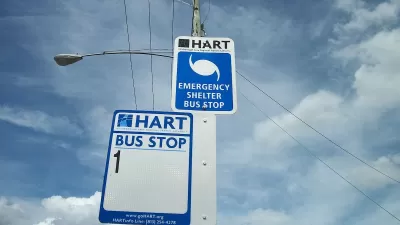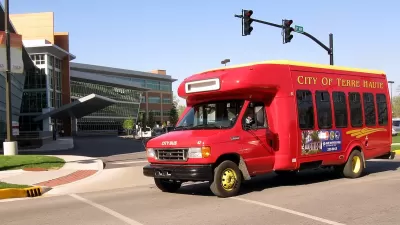Jean-Francois Mayet, the mayor of Châteauroux, introduced free ridership in a bid to turn around his town's failing transit system. Eleven years later, total ridership has increased 208 percent. Henry Grabar examines whether free transit is scalable.
Châteauroux isn't the first city to offer free public transportation, but it's the first example of a large city to do so. Henry Grabar observes, "the otherwise ordinary French town has become a canary in the coal mine of transportation policy, closely watched by the dozens of other municipalities in various stages of free transit experiments." A French report [PDF] released this year found that per person ridership in Châteauroux is up from 21 to 61 trips a year; and the city turned a profit in '03, '04, '05, and '07, after eliminating bus fares in 2001.
"The motivations for making a transit system free are obvious," writes Grabar. "Increased ridership can relieve traffic, improve the environment, boost the system's efficiency, give residents more spending money, help the poor, and rejuvenate central business districts." The results of free mass transit in Châteauroux have been positive, but "[t]here were growing pains: the number of slashed or tagged seats grew from a dozen in 2001 to 118 in 2002. Drivers complained that passengers treated the bus like a personal car, expecting to be dropped off at their doorsteps."
Bruno Cordier, author of a 2007 report Totally Free Mass Transit [PDF], attributes Châteauroux's success to not only free ridership, but also the simultaneous expansion of its transit network. He cautions that "[g]ratuity alone does not make the network attractive" and argues that "the system won't work at all in big cities, where 30-40 percent of transit revenue comes from ticket sales, as opposed to a mere 14 percent in Châteauroux."
The demonetization of the transit system in Aubagne (pop 100,000) has also proven successful, but the verdict on whether the same can happen in big cities will soon be put to the test. "At the end of this year," reports Grabar, "Tallin, Estonia (pop. 406,000) will eliminate fares on its transit system for residents, making it the world's biggest city with free mass transit."
FULL STORY: What Really Happens When a City Makes Its Transit System Free?

Manufactured Crisis: Losing the Nation’s Largest Source of Unsubsidized Affordable Housing
Manufactured housing communities have long been an affordable housing option for millions of people living in the U.S., but that affordability is disappearing rapidly. How did we get here?

Americans May Be Stuck — But Why?
Americans are moving a lot less than they once did, and that is a problem. While Yoni Applebaum, in his highly-publicized article Stuck, gets the reasons badly wrong, it's still important to ask: why are we moving so much less than before?

Using Old Oil and Gas Wells for Green Energy Storage
Penn State researchers have found that repurposing abandoned oil and gas wells for geothermal-assisted compressed-air energy storage can boost efficiency, reduce environmental risks, and support clean energy and job transitions.

Updating LA’s Tree Rules Could Bring More Shade to Underserved Neighborhoods
A new USC study finds that relaxing Los Angeles’ outdated tree planting guidelines could significantly expand urban tree canopy and reduce shade disparities in lower-income neighborhoods, though infrastructure investments are also needed.

California's Canal Solar Projects Aim to Conserve Resources and Expand Clean Energy
California’s Project Nexus has begun generating electricity from solar panels installed over irrigation canals, with researchers and state agencies exploring statewide expansion to conserve water and boost clean energy production.

HHS Staff Cuts Gut Energy Assistance Program
The full staff of a federal program that distributes heating and cooling assistance for low-income families was laid off, jeopardizing the program’s operations.
Urban Design for Planners 1: Software Tools
This six-course series explores essential urban design concepts using open source software and equips planners with the tools they need to participate fully in the urban design process.
Planning for Universal Design
Learn the tools for implementing Universal Design in planning regulations.
Heyer Gruel & Associates PA
City of Moreno Valley
Institute for Housing and Urban Development Studies (IHS)
City of Grandview
Harvard GSD Executive Education
Salt Lake City
NYU Wagner Graduate School of Public Service
City of Cambridge, Maryland





























